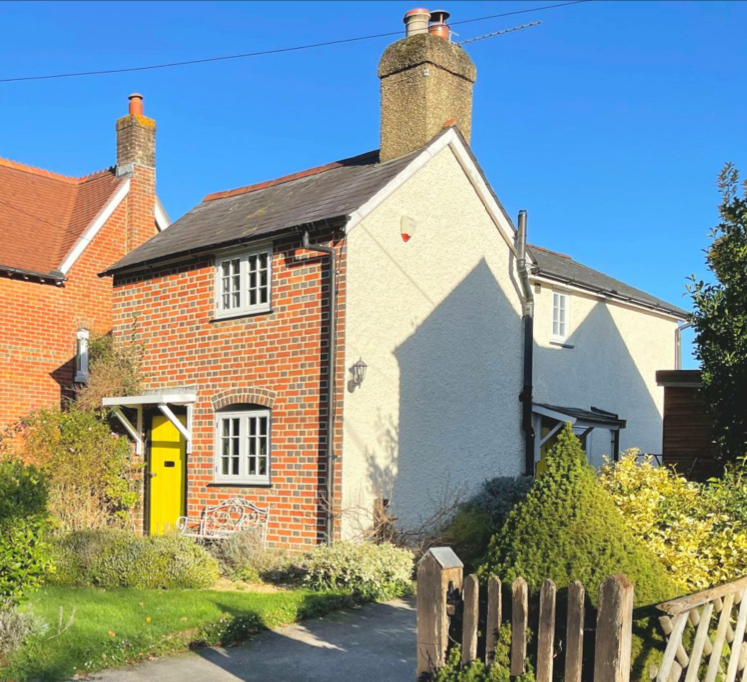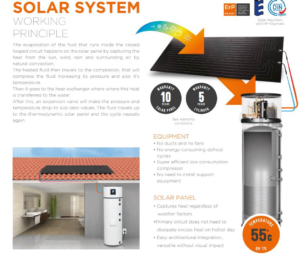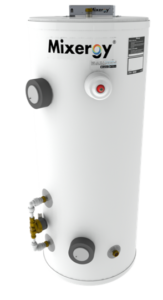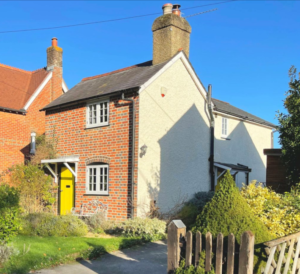
Historic with newer extensions upgrades Q+A
GBE > Encyclopaedia > Code > Question+Answer > Q#41286
About:
Historic with newer extensions upgrades Q+A
GBE Questions & Answers
On 5 Dec 2023, email from ex-student of mine from Southbank University, studying Architecture.
I am reaching out and wondering if I can seek your advice and knowledge.
Response 1:
In the absence of many details, it easy to make poor or incorrect suggestions so you should not rely on anything I say and work it out and confirm it yourself.
Despite that I will give my best advice, which is more joined-up than many other sources.
Consider making a call for more detailed discussion.
https://greenbuildingcalculator.uk/schedule-a-meeting-or-call/
Context 1:
I am lucky enough to own with my partner a lovely little cottage in Hampshire, built around circ.1770.
The original cottage was constructed as solid 1 brick Flemish bond.
Over the years it has had a rear 2 storey extension added in traditional cavity brick/block construction along with a single storey rear conservatory.
Response 2:
The original cottage construction potentially ‘breathes’ moisture, may be very air-leaky and is probably poorly insulated and expensive to keep warm.
The extension is probably better insulated than the cottage but depending upon the date poorly insulated by today’s standards and probably very air-leaky and has thermal bridges.
The conservatory is probably substantially glazed, so poorly insulated, hot in summer and cold in winter; if heated can be a big drain on heating costs, if open plan with the extension it probably is a major barrier to achieving a warm home.
Regulations require doors between conservatory and house, many people remove them and 80% of conservatories in the UK are heated and lots of people choose to live in their conservatory all year rather than retreat to a warm cave.
Conservatory manufacturers are now offering insulated roofs, probably with the wrong insulation materials so will not stop solar radiant heat getting in and preventing it getting back out. The Victorians also understood the need for ventilation openings in the side and top of conservatories, these insulated roofs prevent venting out of the roof, if it ever had vents in the roof in the first place.
SunSpace WinterGarden Conservatory (CPD) G#294 N#295
Question 1:
The cottage is as you can imagine lovely, however a little poor at heat retention, I am therefore considering installing sheep’s wools between the void of the first floor, floor joists and in addition up rate the existing rock wool slab insulation in the loft space.
I have two concerns, one that the building still breathes and two is sheep’s wool the best product when used over existing rockwool?
Answer 1:
Insulating the intermediate floors and partitions to keep the heat in one place is a good idea.
You can then choose to heat, cool and/or ventilate one room at a time rather than the whole house without affecting the adjacent rooms.
I am confident that whatever the roof covering, adding more mineral wool for winter insulation will exacerbate any attic or top floor overheating in summer.
GBE Overheating (CPD) G#15750
GBE Issue Paper Overheating (Shop) G#10433
You need Specific heat capacity, density and k value (decrement factor and decrement delay) in the roofs.
Mineral wools including stone wool, glass wool or slag wool or expanded, extruded or foamed plastics will not provide it.
You need Dense or Flexible wood fibre or cellulose fibre flake, etc. in the loft to stop the solar radiant heat getting in and conducted heat getting out.
How Insulation Works (Properties) G#41275
I am confident that sheep’s wool will work well in winter but not sure how it works in summer.
The existing rockwool may need to be replaced.
GBE Overlaying Loft Insulation (Q+A) G#38593
Rockwool does not ‘breath’ it just leaks heat by slow air movement through the open fibres.
‘Breathing’ is about hygroscopicity but mineral fibres are hydrophobic, therefore completely wrong properties.
How Insulation Works (Properties) G#41275
Natural fibres breath and have decrement delay characteristics.
Natural fibre insulation will passively help the old building dry out slowly over the life of the building.
Mineral fibres and plastics do not perform the same way as natural fibres and can help the building remain moist.
If you have loft cold water cistern, make sure it is insulated competently.
Attic cistern thermal insulation enclosure (Defects) G#1041 N#1058
At the eaves of the older building insulation will be compromised by reduced thickness and wind washing.
Wind Wash (Jargon Buster) G#14021
Make sure you are not squashing your loft insulation with stored stuff.
Lift your loft stuff. Add storage deck above insulation and ventilation zone.
Squashed Loft Insulation (Issue Paper) G#13919
LoftZone StoreFloor (CPD) G#14598
Make sure additional insulation is laid on top of framing zone insulation, at right angles to roof timbers to reduce and eliminate any gaps.
Overlaying Loft Insulation (Q+A) G#38593
Suggestion 1
Are you going to insulate the original external wall?
Consider insulated render on the side walls of the old part of the house if the verge details permit or can be modified to suit.
Using dense wood fibre insulation with a compatible render system; do not use plastic or mineral wool insulation.
Insulate the perimeters, abutments and behind external rainwater goods and any soil & vent pipes
GBS M21 Insulation With Rendered Finish (Navigation) G#9468
Question 2:
I am wanting to upgrade the domestic hot water (DHW) heating and have been considering two products:
Question 2A:
Fischer do a small internal air source internal heat pump.
To not spoil the look of our property.
My concern is its efficiency and noise in an internal environment.
Answer 2A:
In principle a move to Air Source Heat Pump (ASHP) away from Gas or Oil is a good thing, but there are other considerations to address:
Electrical input is ideally Renewable Electricity from any of the following, or a blend from the mains, of PV, PVT, wind, tide, wave, current, hydro-electric, etc.
In order to cool the interior of the fridge or freezer they pump out heat into the room, not ideal in summer.
Overheating fridges and freezers are one of the most frequent sources of house fires.
Heap pumps do the opposite to heat the domestic hot water DHW some coolth must be released, intuitively coolth internally may not be a great idea in winter.
Always extremely well insulate the pipes, joints, valves, etc. between ASHP and DHW cylinder.
Keep the distance between ASHP and DHW Cylinder as short as possible.
Air Source Heat Pump (ASHP) is ideally placed in hot spot: in a sunny corner of the garden surrounded by solid walls soaking up and reradiating the suns heat for the ASHP to optimise.
Possibly place ASHP in the attic but that is a cold spot in the winter unless warmed by solar radiant heat.
A project is Scotland collected winter heat from under roofing slates at 8 degrees warmer than ambient to preheat their system.
Old building with lime-based mortar and lime-based plaster might not like the ASHP vibrations over the life of the building.
Roof timbers might not like the ASHP vibrations over the life of the building, acoustically isolate your kit.
You might not like the noise but compare it with the house heating/DHW boiler noise and heating circulation pump noise and then decide.
Suggestion 2A:
If you are going to adopt ASHP for DHW consider it for room heating too but many other issues need to be addressed if you do, radiators may need changing, put radiators on internal walls not external walls.
You can get magnetic flexible sheets to attach to back face of radiators to reflect the heat back at the radiator and voiding warming the external wall and the great outdoors.
Always extremely well insulate the DHW Cylinder.
Always extremely well insulate the DHW distribution pipes especially when hidden in voids or buried in floors.
Never use heat pumps for room heating unless the building is fully well insulated, or you will not get the performance you expected.
PAS 2030 and 2035 slogan (adapted by me): No (more) Insulation without ventilation.
Consider Mechanical Ventilation with Heat Recovery (MVHR) and summer bypass through the wall vents, units are available for wet or dry rooms.
Or better still whole house MVHR with all of its challenges.
Question 2B:
Alternatively I am considering the use of Thermos Dynamics by Energie to heat hot water.

Answer 2B:
If it is the same technology I first came across it 5 or more years ago, at the time the rep made amazing Coefficient of Performance (COP) claims (6 if my memory serves me well, meaning for every unit of input electrical energy there are 6 units of output heat) but he could not substantiate it and the number he had appeared to miss out lots of important issues and it used mains electricity not renewable electricity.
I would like to think it works and would like to see the true figures.
Using electrically driven cooling of a refrigerant liquid (like fridges and freezers) pumped via pipes to external dark coloured metal panels which are cooled down until cold and covered in frost, then the daytime sun and ambient air and night-time ambient air will defrost and warm the panels and warm the internal liquid which is returned to pre-warm of fully warm DHW or heating.
5 or more years ago, mains electricity was higher carbon than gas, but today mains electricity compares favourable and will continue to improve as more renewable energy is added to the mix.
This week I saw some of this technology at CIBSE Design2Perform exhibition claiming a COP of 4 which is respectable and believable.
Question 2C:
Can you comment on the cross use of sheep’s wool and do you have any experience with regard heat pumps and older style properties and are less than ideal for modern high thermal insulation and air tightness demands.
Answer 2C:
Never use heat pumps for room heating unless the building is fully well insulated, good airtightness and thermal bridge free and purposefully ventilate with heat recovery or you will not get the performance and savings you expected.
That applies to any method of building and its performance.
Original building needs to be well insulated.
Extensions needs to have improved insulation, insulate the cavity if it is not insulated, determine all thermal bridges and air leaking and solve competently.
Make sure you have high performance doors to separate the conservatory from the house, don’t heat the conservatory, ‘retreat into the warm cave in winter’.
Suggestion 2B:
Consider Infrared (IR) electric (or piped liquid) heating from the insulated floor ceiling or insulated internal partitions, zoned to where you linger longest?
Consider Mixergy “Internet or Tanks”, Internet of Things (IOT) connected DHW?
Intelligently heated by cheap energy, by monitoring prices; low cost, free, sometimes they pay you when supplying you with electricity, if you take it at times of low demand and high production, example: overnight.
Heat is introduced at the top of the cylinder making the most of stratification within the cylinder keeping storage and utilisation to the optimum.
Smart Hot Water Tank (Blog) G#20220
Consider SunAmp thermal storage for DHW?
There is now a domestic heating boiler that works in the same way as Mixergy.
Suggestion 3
If you have and use the shower more than the bath consider adding a shower waste water heat recovery device into your plumbing.
N13 Sanitaryware (Checklist) G#956 N#976
Historic with newer extensions upgrades (Q+A)
Brian Murphy ONC HNC Construction BSc (Hons) PGDip Arch (Dist)
01733 238148
07973 281024
Skype: BrianSpecMan (email first)
BrianSpecMan@icloud.com
Twitter: http://twitter.com/BrianSpecMan
Facebook: http://www.facebook.com/BrianSpecMan
National Green Specification Ltd.
Green Building Encyclopaedia
https://GreenBuildingEncyclopaedia.uk
Green Building Calculator
https://GreenBuildingCalculator.uk
Green Building Learning
https://GBELearning.com
© GBE GBC GRC GIC GGC GBL NGS ASWS Brian Murphy aka BrianSpecMan ******
6th December 2023 – 3rd April 2024
Historic with newer extension upgrades Q+A
Images:

Historic with newer extensions upgrades (Q+A)
See Also:
GBE Sign Up
- GBE Membership (Sign-Up) G#23472
GBE #Hashtags
GBE Slogans
- Build Light Insulate Right Solar Tight (Slogan) G#2272
- Fabric First Materials First Performance First (Slogan) G#17243
- Stuffed Loft; Squashed Insulation; Lift Your Loft Stuff (Slogan) G#13957
GBE Q&A
Legend
- Statement No.: S1, S2, etc.
- Observation No.: O1, O2, etc.
- Comment No. C1, C2, etc.
- Question No.: Q1, Q2, etc.
- Answer No.: A1, A2, etc.
Pages
- Energy Saving and Noise Reduction (Q+A) G#3204
- Energy & Acoustics in one measure (Q+A) G#1484 N#1444
- External Wall Insulation (Q+A) G#40828
- Mould and Clean up (Q+A) G#40985
- Overlaying Loft Insulation (Q+A) G#38593
- Primitive Materials Future Building (Q+A) G#16244
- Retrofit External Wall Options (Q+A) G#40938
- Renewable Energy-ready design (Q+A) G#40833
- Removing Cavity Wall Insulation (Q+A) G#38597
- Solid External Wall Internal Thin Insulation (Q+A) G#11367
- Suspended timber floor retrofit insulation (Q+A) G#3870
- Sustainable Design Manufacturer’s Information (Q+A) G#20468
GBE Blog
- Smart Hot Water Tank (Blog) G#20220
GBE Checklist
- Decent Homes (Checklist) G#1571 N#1507
- Refurbishment Decent Homes (Checklist) G#1253 N#1252
- Green Deal Refurbishment (Checklist) G#730 N#752
- Other issues (Checklist) G#1570 N#1506
- GBE New Build Checklist (Navigation) G#606 N#627
- A94 Airtightness testing on-site (Checklist) G#1720 N#1622
- A95 Infra-Red Thermographic Surveys (Checklist) G#1721 N#1623
- B11 Prefabricated Building Units (Checklist) G#1634 N#1553
- C Existing Site/Building/Services (Checklist) G#1558 N#1498
- F10 Brick/Block Walling (Checklist) G#1647 N#1561
- G Structural/ Carcassing metal/ timber (Checklist) G#1596 N#1526
- G20 Carpentry Timber Framing First Fixing (Checklist) G#1597 N#1527
- H Claddings Coverings (Checklist) G#1735 N#1635
- H21 Timber Weatherboarding (Checklist) G#11946
- K43 Raised Storage Access Systems (Checklist) G#13934
- L10 Windows (Checklist) G#1605 N#1534
- L10 Windows Rooflights Screens Louvres (Checklist) G#1604 N#1533
- M21 Insulation With Rendered Finish (Checklist) G#9442
- N13 Sanitaryware (Checklist) G#956 N#976
GBE Issue Papers
- Squashed Loft Insulation (Issue Paper) G#13919
GBE CPD
- Surveys Tests Analysis (CPD Lecture) G#389 N#390
- Refurbishment Decent Homes Checklist (CPD) G#644 N#666
- Retrofit PAS 2035 (CPD) G#21613
- Sustainable Refurbishment Materials Specification (CPD) G#38046
- SunSpace WinterGarden Conservatory (CPD) G#294 N#295
GBE Lectures
- (13.1) Ground Floor (Lecture) G#2112 N#213
- (21) Masonry External Walls (Lecture) G#2115 N#216
- (21) Timber Frame (Lecture) G#2117 N#219
- (23) Upper Floors (Lecture) G#2120 N#222
- (27.2) Pitched Roofs (Lecture) G#2122 N#224
GBE Shop
- GBE Lecture (13.1) Ground Floors (Shop) G#11561
- GBE Lecture (21) Masonry External Walls (Shop) G#11559
- GBE Lecture (23) Upper Floors (Shop) G#11554
- GBE Lecture (27.1) Flat Roofs (Shop) G#11501
- GBE Issue Paper Overheating (Shop) G#10433
- LoftZone StoreFloor CPD Handout (Shop Free) G#16383
- LoftZone StoreFloor CPD (Shop) G#16381
Historic with newer extensions upgrades (Q+A)
GBE Defects
- Weather Protection (Defect) G#728 N#750
- Attic cistern thermal insulation enclosure (Defect) G#1041 N#1058
- Loft Insulation (Defect) G#14166
GBE Issue Papers
- Squashed Loft Insulation (Issue Paper) G#13919
- Overheating (Issue Paper) G#145
GBE Brainstorms
GBE Products
- Diathonite Evolution (Product) G#1796 N#1683
- Breathaplasta (Product)
- Breathaboard (Product)
GBE Accessories
GBE Systems
- Mixergy
- SunAmp
GBE Materials
- Aerogel
- Cellulose flake recycled newspaper
- Clayboards
- Clay plasters
- Dense wood fibre Insulation
- Glass wool
- Hemp-lime
- Stone wool
- Vacuum Insulated Panel (VIP)
GBE Properties
- How Insulation Works (Properties) G#41275
GBE Manufacturers
- Adaptavate (Manufacturer)
- Ampack
- Argilus
- Diasen
- EBB
- Eco Answers Ltd t/a LoftZone (Manufacturer) G#13890
- Enviroform Solutions Ltd (Manufacturer) G#4728
- Gutex
- Insumate Ltd (Manufacturer) G#1761 N#1657
- Lime Technology
- Lime Green
- Mixergy
- Pavatex
- ProClima
- Schneider
- Steico
- Sunamp
- Ty-Mawr Lime Ltd (Manufacturer) G#891 N#911
- Unger Diffutherm
GBE Suppliers
- Back to Earth (Supplier)
- Eco Answers Ltd t/a LoftZone G#13890
- EcoMerchant (Supplier) G#887 N#907
- Ecological Building Systems (Supplier) G#886 N#906
- Mike Wye & Associates (Supplier) N#910
- NBT Natural Building Technology (Supplier)
- Partel (Supplier)
- Ty-Mawr Lime Ltd (Manufacturer Supplier) G#891 N#911
GBE Installers
GBE Servers
- Enviroform Solutions Ltd G#4728 (advice on all insulation types, provide fit for purpose solutions)
GBE Projects: Events
© GBE GBC GRC GIC GGC GBL NGS ASWS Brian Murphy aka BrianSpecMan ******
9th December 2023 – 3rd April 2024
Historic with newer extensions upgrades (Q+A) Q#41286 End.
GBE Question & Answer (Template) Q#14864



